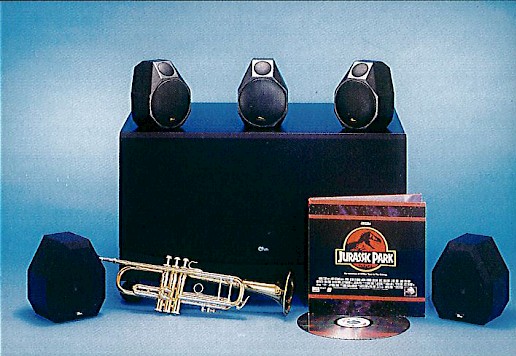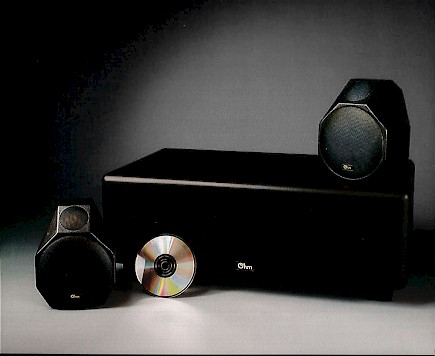Subwoofers: Active or Passive - They Take the Low Road
Subwoofers: Active or Passive – They Take the Low Road
Subwoofers are speakers designed to reproduce the sounds lower in frequency than the system’s woofer can handle. To extend the low frequency range of a speaker system, an extra-large speaker is often needed. Today, subwoofers are very popular particularly in home theater systems when movie sound effects like train crashes or thunder need very loud, very deep bass. Subwoofers can be passive (driven by the main amplifier) or active (with their own amplifier). There are advantages and disadvantages with both designs.

Active Subwoofers
When Dolby Digital 5.1 was chosen as the standard for DVDs with five main channels and one subwoofer channel (aka Low Frequency Effects channel), powered subwoofers became the norm for home theater systems. The Home Theater processor removes the bass from all channels and sends it to the LFE channel with little detrimental effect on the overall sound quality if the subwoofer is properly located in the room. The main speakers can be much smaller when they don’t have to reproduce the deep bass. Of course, a more powerful subwoofer may be needed to reproduce all the low frequency information for all six channels, but these are readily available. The subwoofer can be more powerful without the sacrifice of having to bring a bigger box into your room, since the subwoofer’s dedicated amplifier allows it to be equalized. This convenience comes at the price of extra audio processing, an extra amplifier (often quite large) and a long-throw, high-power handling driver.
With a two-channel music system, some of these trade-offs also affect the sound quality. When you process the two-channel signal to extract the deep bass information, you dramatically increase the difficulty of matching the mains to the subwoofer(s) and matching the system to the room. Two-channel preamps rarely have subwoofer outputs, so an extra electronic crossover must be added to the system. Subwoofer placement becomes critical. Sound levels, timing and phase all become troublesome in the crossover region between the mains and the subwoofers. Some subwoofers have lots of processing power built in; but if it is a single subwoofer, this usually only works well in one seating location – not nearly the whole listening area. These may not be serious concerns in a home theater system, but for music systems, you’ll find that they dramatically affect the sound quality.

Passive Subwoofers
Passive subwoofers do not have built-in amplifiers and are usually designed to work best with specific satellite speakers. This has two major advantages. One, the designer can optimize the crossover from the subwoofer to the specified satellites and have recommended placement for all the speaker parts. If you can apply these recommendations, you know you are getting the best sound possible from the design. Two, the cost can be minimized as no separate subwoofer amplifier is required.
There are some problems. You cannot use the LFE output from your home theater processor unless you buy an extra power amplifier. Without the equalization from the subwoofer’s power amplifier, bigger cabinets are needed to have the same deep bass response. The slow roll-offs in passive crossovers usually make speaker placement more important for seamless reproduction. You must follow the manufacturer’s placement recommendation or you may lose mid-bass music, like tuba and some drums, at certain spots in the listening room. It is usually better to have the subwoofer up front, in between the two main speakers. It is best if you have two subwoofers acting as stands for the mains. The placement becomes critical to sound quality when the mains become very small and the subwoofer is expected to reproduce some of the voice range.
The Dancing Dog Problem
In carnival shows, it is not how well the dogs dance that is important; but that they dance at all. This is the case with many systems using very tiny main satellite speakers with a big subwoofer hidden out of site. You can hear the bass and find it amazing to come from the small, visible satellite speakers. Their severe cross over problem can usually heard by listening to male voice from an off-center location. It is best to have the mains reproduce all the voice range.
This is why THX and Dolby-Digital specify an 80 Hz crossover. In our experience with subwoofers being used as the speaker stands for the mains, a crossover as high as 100 Hz can be used. In general, the farther the subwoofers are placed from the main speakers, the lower the crossover frequency must be, which, in turn, necessitates larger and larger satellite speakers to reproduce the lower frequencies.
To Summarize:
Active subwoofers are ready to roll in home theater systems when driven from the LFE (subwoofer output) and they can use physically smaller boxes for the same bass response because the built-in amplifier can have equalization (bass boost). If all the main and surround speakers are called small in your processor, your amplifier can play louder over their limited range.
Passive subwoofers can allow much smaller main speakers in both music and home theater systems with the deep bass coming from the subwoofer. They are better for the designer, because unlike active subwoofers, they don’t rely on the end user making good decisions. And for the end user, they are more cost effective for good sounding two-channel music systems.
Placement of the subwoofer is important in both cases and critical if the mains are very small.
There are trade-offs with each configuration that the speaker designer must choose and you need to consider what works best in your room and system.
Enjoy & Good Listening,
John
Subscribe to Ohm News & Views to get the latest posts in your inbox
John Strohbeen Author
John Strohbeen was the President and Chief Engineer of Ohm Acoustics from 1978-2023.


